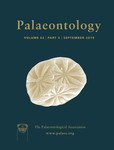Reg. Charity No. 1168330

Eublastoids are a large clade of blastoids; stemmed blastozoan echinoderms diagnosed by their conservative body plan (three basals, four deltoid plates and five radial plates), lancet plate supporting the ambulacra, and hydrospire respiratory structures. Although Eublastoidea was a highly successful clade in the middle and late Palaeozoic it is absent from early echinoderm radiations seen in the Cambrian and Ordovician record. Here we provide a re‐evaluation of Macurdablastus uniplicatus Broadhead from the Ordovician, using detailed morphological assessment based on advanced synchrotron tomography and phylogenetic analysis. Macurdablastus uniplicatus falls outside Eublastoidea because of the morphological differences in lancet plate and respiratory structures. The oldest recorded eublastoid is thus middle Silurian in age. The re‐evaluation of the morphology of Macurdablastus provides a basis for revising blastoid phylogeny and classification.